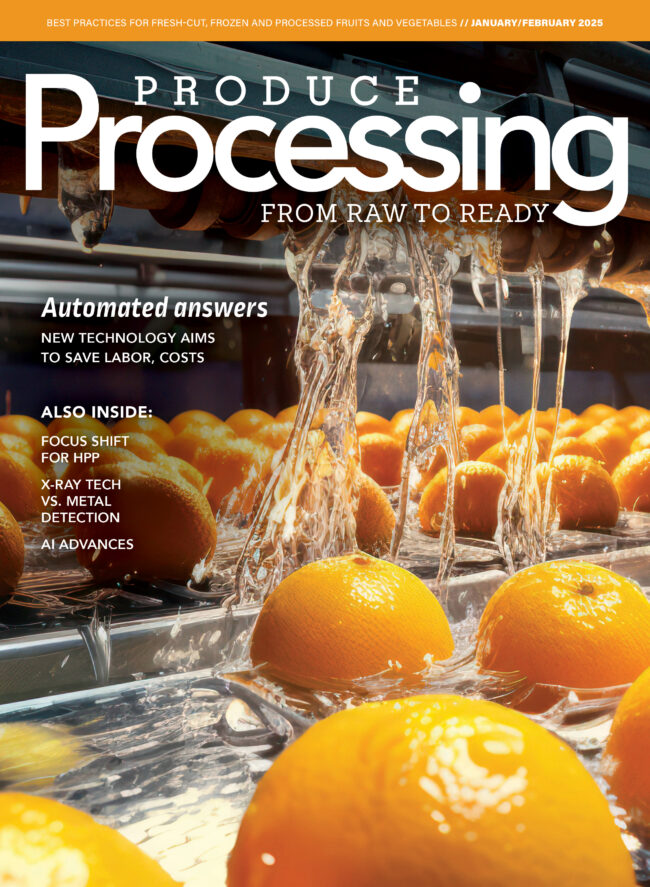Processors seek ‘greener’ produce packaging
Consumer demand for healthy food will drive growth in the produce packaging market from $33.6 billion in 2021 to $42.7 billion in 2027, at a 4.1% compound annual growth rate.
Packaging preferences are being determined by the need for attention-grabbing shelf impact, reduced handling, increased shelf life and achievement of sustainability goals.
Eco-friendly materials are in demand, and renewable corrugated continues to be the most widely used material, often combined with fiber-based tissue, cups and/or pads to protect produce from damage, maximize shelf life and minimize waste. Renewable molded-fiber packaging is sparking interest, as is polymer-based flexible packaging, particularly as an alternative to heavier clamshell packaging. The film’s lighter weight can offer a smaller carbon footprint, combined with attractive 360-degree graphics and convenience features like reclosable zippers and die-cut carry “handles.”
Reusable packaging
A few companies are working to establish a circular economy for agricultural films and produce packaging. The effort to achieve a circular economy — where products and packaging are recovered and converted into new products and packaging — involves a multifaceted approach, according to “Achieving Packaging Sustainability,” a report from PMMI, the Association for Packaging and Processing Technologies. To achieve a circular economy, CPG companies must:
● Look for opportunities to adopt reusable packaging, which can make multiple trips between the manufacturing operation and retailer/consumer
● Collaborate more closely with recyclers
● Take a more active role in recycling
● Use more recycled materials
● Sustainability goals
When produce processors set sustainability goals, they need to look at products, packaging and operations holistically and collaboratively. “Sustainability presents an opportunity for businesses facing increasing competitive and economic pressures to gain value and competitive advantage as they respond to environmental concerns and the pressures of resource scarcity, population growth, and higher and more varied consumer expectations,” according to the PMMI report. The challenge is to determine what action(s) will maximize the positive impact on waste, costs, recycling, efficiency and the transition to a circular economy. To achieve sustainability goals, produce processors should:
● Understand in-house sustainability targets and establish key performance indicators so results can be measured
● Involve a third-party auditor to help optimize operations
● Involve recyclers
● Involve producer responsibility organizations
● Participate in legislative efforts and standardization work
Success depends on collaboration with materials providers, OEMs and other stakeholders. Wherever possible, produce processors should:
● Consider carbon impact as part of the business case for any action
● Shift to green energy sources
● Specify machines that consume less energy
● Retrofit machines to run sustainable materials
● Reduce consumables like lubricants, inks, adhesives and labels
● Lightweight containers, closures and packaging materials
● Generate less waste
● Specify renewable, recyclable and/or recycled-content packaging material
● Use less plastic
However, these actions must be evaluated for potential negative consequences and should be thoroughly tested before adoption. For example, if a change in structure and/or materials reduces protective qualities, damage rates may rise. Damaged product that is rejected or returned increases waste, adds costs, delays delivery, impacts sales and hurts the reputation of the company/brand.
Greenwashing
Care also must be taken to avoid “greenwashing,” the listing of unsubstantiated claims and environmental attributes. In the U.S., the Federal Trade Commission regulates environmental marketing claims under Section 5 of the Federal Trade Commission Act, which “prohibits unfair or deceptive acts or practices in or affecting commerce.” The agency’s Green Guides help stakeholders determine which claims are appropriate. Environmental labeling requirements also are outlined in ISO 14020.
Efforts on sustainability will be featured at PACK EXPO International (Oct. 23-26, 2022; McCormick Place, Chicago), where a PACK EXPO Green icon identifies exhibitors that provide renewable, biodegradable, source-reduced, recyclable and/or recycled-content packaging materials or technologies that reduce carbon footprint. Sustainability related educational sessions also will be offered, and the Reusable Packaging Association is once again sponsoring the Reusable Packaging Pavilion and the Reusable Packaging Learning Center. For more information, visit packexpointernational.com.







